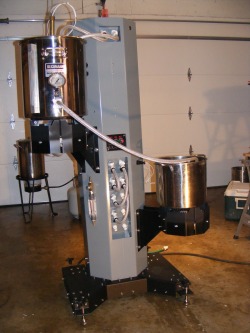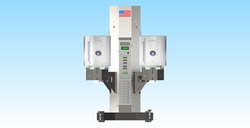
The Beer Rocket is a HERMS brew sculpture.
Temperature and fluid level sensors assist the on board brew computer in managing the recirculation and temperature control needed for the mashing and sparging processes.
All system functions can also be controlled using the manual overide switches located on the control panel.
Fluid routing through internal system components is quickly and easily configured using the bank of quick disconnect fittings located on the front.
 The New Beer Rocket 1000
The New Beer Rocket 1000
A new upgrade is brewing. It promises the control and ease of use that will make brewing a batch of beer almost as easy as making a cup of coffee. We're taking what we've learned from the past 40 batches and adding a dose of design and technology to create a brewing process that is perfectly repeatable and literally requires only adding the grain to the mash and the hops to the brew pot. We could automate that as well, but , hey, we need to feel like were doing something!
| the_beer_rocket.pdf | |
| File Size: | 51683 kb |
| File Type: | |
Note:The file above must be opened using Adobe Acrobat Reader , other PDF utilities will not open the file.
Batch #27 American Amber Ale Data Log

The recipe is formulated, the grains are measured and crushed during the initial mash tun fill and warm up phase. When the temperature of the mash tun achieves the target mash temperature the mash-in is performed and the system brings the mash temperature up to the set-point temperature and maintains it for 1 hour.
The brown trace is the mash temperature and typically varies by less than 1°F from the set-point.
The black trace is the RIMS Out temperature and indicates the temperature of the recirculated mash water exiting the RIMS heat exchanger. Note that very little heat is added to the recirculated mash water and its temperature at the outlet of the RIMS heat exchanger is also very stable.
The gold trace is the water temperature inside the heat exchanger near the top. When the heating element is turned on the heated water inside the heat exchanger rises immediately to the top. This gives some indication of the on-off duty cycle of the heating element. Note: This is not the temperature of the mash water. The mash water is routed through the interior of the heat exchanger thru a copper coil.
